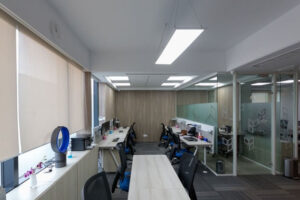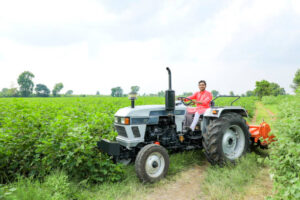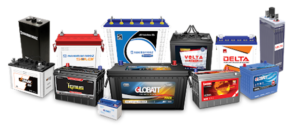
Lead-acid Battery Industry in Bangladesh
The Business Standard estimates that the lead-acid battery market in Bangladesh is valued at roughly BDT 10,000 crore. The Business Post claims that within the last ten years, the industry’s size has grown three to four times. The market participants may generate about 40 lakh batteries a year, depending on their production capability. Rahimafrooz Group was established in 1954 and is a pioneer in the local lead-acid battery market. In 1985, the company began manufacturing industrial batteries. Rahimafrooz Batteries Limited is currently the leading producer of lead-acid batteries in the nation, manufacturing 200 varieties of batteries for a range of uses.
The Rahimafrooz Group also includes Rahimafrooz Globatt Limited and Rahimafrooz Accumulators Limited as two additional companies. These companies manufacture specialty batteries for use in automobiles and machinery. In addition, there are about 25 domestic producers in Bangladesh that make batteries for systems including solar panels, simple bikes, battery-powered rickshaws, commercial vehicles, passenger transportation, IPS and UPS systems, telecommunication towers, and more. Several well-known brands in Bangladesh’s lead-acid battery manufacturing sector include Navana, Hamko, Panna, General, Rimso, Rangs, and others. Over one lakh individuals have been directly or indirectly employed by the sector.
According to a report by Mordor Intelligence, the lead-acid battery market in Bangladesh is anticipated to grow at a Compound Annual Growth Rate (CAGR) of above 3% between 2022 and 2027. The lead-acid battery industry’s growth is anticipated to be hampered by the rising popularity of electric vehicles, which mostly use lithium batteries, and the falling price of lithium batteries.
Market scenario in Bangladesh
Three-wheelers that run on batteries, referred to as “easy bikes,” account for the majority of Bangladesh’s demand for lead-acid batteries. Battery-run rickshaws also fall into this category. A report by The Business Standard states that the number of e-bikes on the streets of Bangladesh has already exceeded 30 lakhs. As policymakers are planning to regularize this mode of transport with the introduction of safer designs of vehicles and licensing procedures, the number of easy bikes and battery-run rickshaws will go up in the future. These three-wheelers currently use almost 60% of the lead-acid batteries made in the nation, according to an industry expert.
In addition, easy bikes typically need five lead-acid batteries to operate, and these batteries have a lifespan of less than a year, resulting in recurring sales for the lead-acid battery manufacturers. 20% of the whole battery demand. However, telecommunication towers, solar panels, UPSs, IPS, and other devices make up about 15% of the overall demand. The remaining 5% is used for additional unique functions.
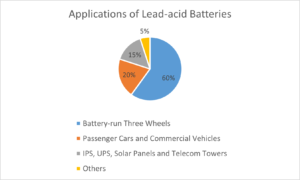
Background of study
The electric rickshaws or E-Rickshaws have been creating a remarkable demand for short-trip travel in urban, semi-urban & rural areas across the country. These rickshaws have been popular due to reducing the physical labor & energy of the pullers & the drivers. In Bangladesh, there are two types of E-Rickshaws available. First, China and, to a lesser extent, India primarily import newly developed and manufactured electric rickshaws. These vehicles go by various names, including “Easy bike” and “Tomtom.” However, another type of electric rickshaw isn’t brand-new or factory-made; instead, local mechanics modify Bangla vans (originally for cargo) and traditional Bangla rickshaws (for passengers) into electric versions. In Bangladesh, people frequently refer to all these e-rickshaws as electric vehicles, or EVs.
In Bangladesh, there are roughly 5-7 lacs of electric vehicles (EVs), all of which are three-wheelers with electric motors that range in capacity from 650 to 1400 watts. These EVs are currently powered by two different kinds of batteries. The first is the VRLA DMZ in conventionally converted vans and rickshaws, and the second is the Low Maintenance (LM ER) Battery, which is a manufactured, in-built, modified arrangement.
Data collection from all over Bangladesh
We have gathered primary data from eight divisions throughout the nation. The divisions of Dhaka accounted for approximately 29.1% of the respondents, followed by Chittagong (14.8%), Rajshahi (7.6%), Khulna (10.0%), Barishal (9.9%), Sylhet (4.3%), Rangpur (14.7%), and Mymensingh (9.6%).
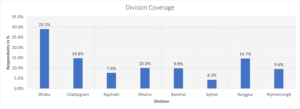

Respondent Type
Among the total respondents, we have covered maximum E vehicle/Mishuk [72.1%] following by E Rickshaw [20.9%] & E Van [7.0%]. Total base sample was 1204 individuals.
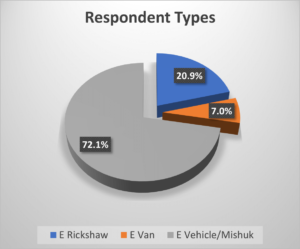
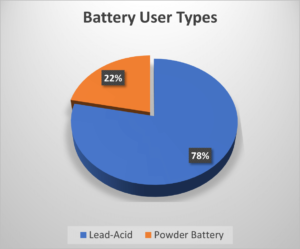
Uses of Power Battery in E-Vehicle/Mishuk
- E-Rickshaw & E-Van are using mostly Powder Battery 71% & 92% respectively
- E-Vehicles/Mishuk are using mostly Lead Acid Battery (99%)
Battery types-wise Brand Share
Most companies are manufacturing lead-acid batteries except for DJDC. They have maximum market share on the Powder battery (89%). However, when it comes to powder batteries, Hamko holds a 22% market share, followed by Navana at 13%, Jack at 14%, PK at 50%, Saif Power at 9%, Power Plus at 2%, E-Long at 3%, and others at 20%. Hamko 78%, Walton 100%, Volvo 100%, DJDC 11%, Navana 87%, Saif Power 91%, Power Plus 98%, E-Long 97%, Jack 86%, PK 50%, Rangs 100%, and other 80% are examples of lead-acid batteries.

For more information, please contact us…

